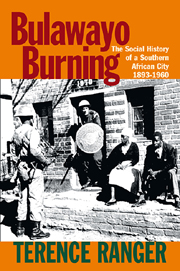Book contents
- Frontmatter
- Contents
- List of Illustrations
- Introduction
- Prelude: Bulawayo, 1893–1930
- 1 The Landscapes of Bulawayo
- 2 The First Fires: December 1929
- 3 City versus State 1930–1946
- 4 Mr Black Bulawayo 1930–1948
- 5 The Feminization of Black Bulawayo 1948–1960
- 6 Black Bulawayo Transformed
- 7 Black Bulawayo Burns 1960
- Postlude: Bulawayo after 1960
- Selected Bibliography
- Index
7 - Black Bulawayo Burns 1960
Published online by Cambridge University Press: 05 April 2013
- Frontmatter
- Contents
- List of Illustrations
- Introduction
- Prelude: Bulawayo, 1893–1930
- 1 The Landscapes of Bulawayo
- 2 The First Fires: December 1929
- 3 City versus State 1930–1946
- 4 Mr Black Bulawayo 1930–1948
- 5 The Feminization of Black Bulawayo 1948–1960
- 6 Black Bulawayo Transformed
- 7 Black Bulawayo Burns 1960
- Postlude: Bulawayo after 1960
- Selected Bibliography
- Index
Summary
The Emergence of the National Democratic Party
On 1 January 1960 a new mass party – the National Democratic Party – was formed in Salisbury. Much of the literature connects or attributes this to Joshua Nkomo. In his autobiography Nkomo himself writes:
At the beginning of 1960 a group of people from the banned African National Congress met to form the new National Democratic Party. Its provisional constitution was almost identical with its predecessor's, and to underline the continuity I was elected president in absentia, while I pursued my work abroad.
Obituaries of Nkomo in leading newspapers gave Nkomo a more active role. The Times on 2 July 1999 asserted that Nkomo ‘responded immediately’ to the ban on Congress ‘with the creation of the NDP, with the same executive and constitution as the ANC, while he campaigned abroad’. Also on 2 July the Guardian obituary affirmed that ‘when the ANC was banned he [Nkomo] formed the NDP – and became its President’. But all these statements are in error.
Nkomo did not form the NDP or stimulate its formation. Indeed, for some time after its emergence he did not know what it was or whether he should throw in his lot with other parties which were seeking to establish themselves at the same time. He was not elected as President in absentia on 1 January nor mentioned as the new party's overseas representative. The last thing that the leaders of the NDP wanted was to underline its continuity with the banned ANC, which would have been fatal under the Unlawful Organisations Act.
- Type
- Chapter
- Information
- Bulawayo BurningThe Social History of a Southern African City, 1893–1960, pp. 217 - 243Publisher: Boydell & BrewerPrint publication year: 2010



